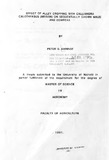Effect of alley cropping with Calliandra calothyrsus (Meissm) on sequentially grown maize and cowpeas
Abstract
A series of trials were conducted at the International Institute
of Tropical Agriculture, Ibadan, Nigeria, between January and
December 1988 to evaluate the potential of calljandra for alley
cropping. In a field experiment, the growth, biomass production
and nutrient yield of calljandra and the growth and yield
performance of sequentially grown maize and cowpea were
assessed. Six treatments were used comprising three nitrogen
rates (0, 45 and 90 kg N ha-1) factorially combined with and
without prunings in a randomized complete block design.
Concurrently, a comparison of the decomposition rates and
nitrogen release of calliandra and maize stover, and that of green
and dry wood of calliandra, leucaena, calliandra, cassia and acioa
was made using the same experimental field and design. In a
greenhouse study, the N-manuring value and residual effects of
dry and green leaves of calliandra and calliandra maize production
were also investigated and compared with inorganic N-source in a
randomized complete block design. Nitrogen from legume leaves
and calcium ammonium nitrate (CAN) was supplied at 0, 50 ppm
and 100 ppm N rates and the plant height, dry matter production
and N-content in tops determined.
Calljandra recorded an impressive one year's growth of 306.7
em, a maximum of 35 coppices per tree and a biomass production
of 5.0 tons Dm ha-1 from four prunings contributing an estimated
nutrient yield of 185 kg N, 13.3 kg P, 64.2 kg K, 55.2 kg Ca and 16
kg Mg ha". Maize plant height and leaf area index were increased
(xv)
by pruning and inorganic N application, but not significantly.
Levels of N, P and Mg in maize earleaves increased with
increasing nitrogen and with pruning application, but only N was
significant while K and Ca remained largely unaffected. Without
prunings, the application of 45 and 90 kg N ha-1 increased total
grain yield by 108 and 176% respectively. With pruning
application, however, the respective yield increases were only 6
and 12%. Prunings alone double maize yield while the addition of
45 kg N increased yields by 12% and that of 90 kg N depressed
yields by 8%. The effect of pruning applicaiton was approximately
equivalent to the application of 45 kg N ha-1. Hedgerows
significantly reduced per plant grain yield of plants grown
adjacent to them, but the latter accumulated more N in grain than
the former.
Pruning application, residual Nand calliandra hedgerows did
not significantly influence cowpea plant height or leaf area index.
Plants near hedgerows' showed higher nutrient status than those
in middle of alleys. Application of prunings significantly affected
weed growth and flora in cowpea crop. Prunings slightly increased
total seed yields and the proximity of cowpea to hedgerows had a
significant positive effect on both number of pods and yield, with
a significant interaction with residual N.
Calliandra prunings decomposed four times faster than maize
stover and green wood faster than dry wood, rates which were
proportional to their respective C:N ratios. The order of
decomposition was leucaena > gliricidia > calliandra > cassia>
(xv i)
acioa. The decomposition rates of cassia and acioa were
significantly different from the rest.
Under greenhouse conditions, inorganic N was a better Nsource
than dry leaves of calliandra at same N-rates while
calliandra was inhibitory at increasing application rate.
Incubation of green and dry leaves for periods of 9, 6 and 3 weeks
did not improve performance significantly, but green leaves were
better than both inorganic N and dry leaves and gave a greater
residual effect on subsequent maize crop.
Citation
Karinge, P.G(1991). Effect of alley cropping with Calliandra calothyrsus (Meissm) on sequentially grown maize and cowpeasSponsorhip
University of NairobiPublisher
Department of soil science, University of Nairobi
Description
Msc- Thesis

